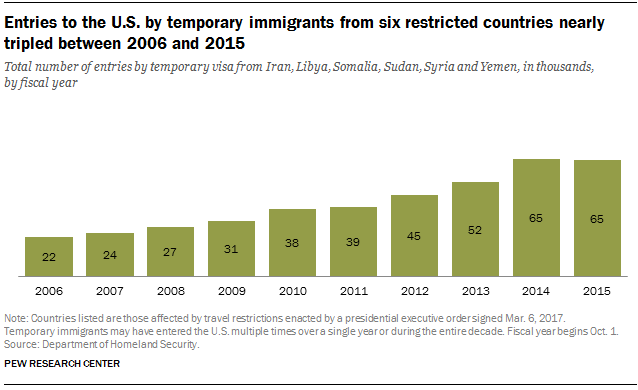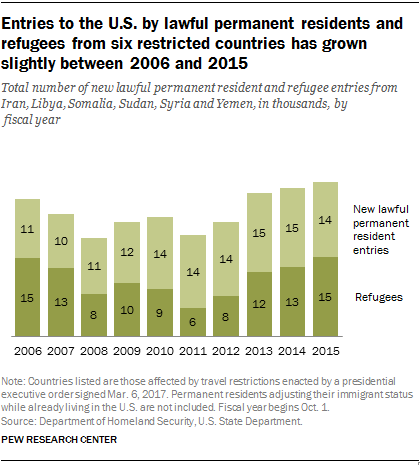
The six nations affected by a new executive order that prevents their citizens from obtaining new visas to enter the United States for 90 days accounted for 649,932 legal U.S. entries between fiscal years 2006 and 2015. This group includes visitors, students and diplomats as well as refugees and new lawful permanent residents, according to a Pew Research Center analysis of government data.
Entries from the affected countries made up about 0.1% of the more than 517 million total entries to the U.S. over the same period. (Entries include individuals visiting the U.S. as well as new lawful immigrants and refugees. They do not include unauthorized entries or asylum seekers. One person may account for multiple entries.)
The new order, signed by President Donald Trump on March 6, takes effect March 16 and supersedes a previous order signed on Jan. 27 that was later blocked by U.S. courts. The new order specifies that most citizens from Iran, Libya, Somalia, Sudan, Syria and Yemen cannot enter the U.S. on new visas until security procedures used to evaluate visa applications have been reviewed; it excludes Iraq, which was a seventh country named in the January order. (A previous analysis by the Center estimated there were more than 900,000 legal entries of citizens from restricted countries between 2006 and 2015 when Iraq was included in the list of restricted countries.)
Diplomats, U.S. lawful permanent residents, dual nationals who use a passport from another country and refugees already scheduled to travel to the U.S. are among the groups exempt from the travel restrictions. The president’s new order will also temporarily halt the U.S. refugee resettlement program for 120 days.
Previously, citizens of the six restricted countries were able to legally enter the U.S. in several ways. Official data are available on three categories of legal entrants: temporary immigrants, refugees and new lawful permanent residents. Government data are unavailable for those who entered as naturalized U.S. citizens, dual nationals (citizens of any two countries) or U.S. lawful permanent residents after their first entry into the U.S.
Nearly two-thirds (409,449) of the total legal U.S. entries from Iran, Libya, Somalia, Sudan, Syria and Yemen between fiscal 2006 and 2015 were admitted using temporary non-immigrant visas. Those on temporary visas were mostly visitors to the U.S., but could also include students, businesspeople, short-term workers and diplomats, according to an analysis of Department of Homeland Security data. Over the period in question, the number of temporary visa entries from the six countries nearly tripled: from about 22,000 in 2006 to nearly 65,000 in 2015. (Temporary immigrants represent events and not unique individuals; individuals may have entered the U.S. multiple times during a fiscal year.)
Over the same period, annual refugee admissions from these six countries fluctuated, but about the same number entered in fiscal 2006 (15,035) as in 2015 (15,243), according to U.S. State Department data. The annual total jumped for these six countries, to 26,842 in fiscal 2016, a year when 12,587 refugees were admitted from Syria alone. In all, 110,003 refugees from these six countries were admitted between fiscal years 2006 and 2015, representing nearly two-in-ten (18%) of all refugee admissions during the period.

The annual number of new lawful permanent residents entering from Iran, Libya, Somalia, Sudan, Syria and Yemen also increased between fiscal years 2006 and 2015, from 11,392 to 14,397 arrivals. This is a group that can include family members of U.S. citizens and awardees of the diversity immigrant visa program. In all, 130,480 people entered the U.S. between 2006 and 2015 as new lawful permanent residents from these six nations, with nearly half (53%) from Iran.
Of the six restricted countries, Iran had the largest total number of legal entrants into the U.S. (310,182) between 2006 and 2015. Two-thirds (67%) of these entrants arrived in the U.S. on temporary visas. Syria had the second highest number of entrants (124,708), with 85% arriving on temporary visas. Meanwhile, 86% of Somalia’s 72,652 entrants during this time were refugees.
Yemen (56,455 entries), Sudan (52,287) and Libya (33,648) had far fewer entries between fiscal years 2006 and 2015 than the other restricted countries. In all three countries, the majorities of entrants entered as temporary visa holders.

